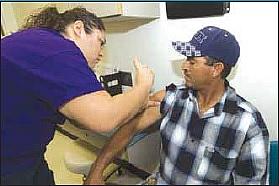Fewer uninsured Latinos in California
Gerardo Fernandez wrote this article for Alianza Metropolitan News as a project for the 2016 California Fellowship, a program of USC Annenberg's Center for Health Journalism.
Other stories in the series include:
Complaint seeks better Medi-Cal access for patients and physicians

The major barriers that keep people from having access to health insurance continue to be affordability, eligibility, and cultural backgrounds.
The number of uninsured Latino Californians has dropped dramatically in the last three years, especially since the implementation of Covered California, the significant increase of Medi-Cal beneficiaries, the expansion of Medicaid and the recent extension of MediCal coverage to undocumented children. However, many continue to be uninsured, and more than half are Latinos.
California has the third highest number of uninsured people in the United States, and Latinos (the largest group in the state) account for 59 percent of people who are eligible for Medi-Cal, but uninsured, according to surveys and data reports compiled by UCLA’s Center for Health Policy Research and UC Berkeley.
The major barriers that keep people from having access to health insurance continue to be affordability, eligibility and cultural backgrounds. Almost half of all uninsured people (46 percent) cited high costs as their main reason for not having health insurance, while 15 percent do not have insurance by choice.
“One very important factor is our culture,” said Pedro Enriquez, a Mexican-born immigrant who has lived in the United States since 1984, and a U.S. citizen since 1998. “We (Mexicans) are slothful. We tend to act only when the problem is major. We come here to work, from Mexico or other countries, that’s our goal. So we forget about paying attention to our health, and think that the problems will go away if we ignore them.”
Another problem, according to Enriquez, is that Hispanic people do not know where to go for assistance.
“We don’t know, and we are ashamed about asking; a major problem within our culture,” commented Enriquez.
Enriquez used to get insurance through his job, but seven years ago he ventured out as a self-employed entrepreneur and has had health insurance on and off. In 2014, he enrolled through Covered California, but lost coverage after forgetting to pay the bills, and is now one of the two million California workers who are uninsured.
He heard about the program through his brother, who heard through his daughter, a nurse in San José.
“I was enrolled in that program, but I keep forgetting to keep up with the payments, that are very low. I then ended up paying more because of the penalties,” explained Enriquez. “I just paid about $300, so now I have to pay attention to that, or I’ll pay more next year.”
Enriquez said he has not used his health insurance. “I only need dental work, but it looks like Covered California does not provide that.” The program began offering optional dental insurance in 2015, yet Enriquez was not aware of that and continued to pay out-of-pocket when he needed dental care.
Covered California has spent over $29 million airing ads in English, Spanish, Mandarin, Cantonese, Korean and Vietnamese. Still, many people, like Enriquez, learn about the program through word of mouth.
Two million people have registered for Covered California, although not everyone is eligible to receive a health insurance premium subsidy because of their income or immigration status. There are about one million undocumented people in the state who cannot enroll through Covered California, and 91 percent of them are Hispanic.
Since the implementation of the Affordable Care Act, the number of uninsured in the state has dropped by half, and it has also “significantly reduced the number of Californians on county indigent care programs,” according to Health Access California, a statewide health advocacy organization.
Starting in May 2016, about 170,000 undocumented low-income children will have access to both Medi-Cal. The Legislature is also considering a proposal, SB 10, to require the state to seek a waiver from the federal government's rules to allow entire undocumented families to use their own money to enroll in insurance plans through Covered California, without subsidizes.
“Moving forward with this waiver is not just an important symbolic step toward inclusion, but will also provide practical benefit and additional access for thousands of Californians,” said Anthony Wright, executive director of Health Access California, a statewide health care consumer advocacy coalition.
“[Undocumented] people right now can go and buy coverage directly from a broker or an insurance plan, but they cannot go through Covered California right now,” said Wright. “We don’t think that’s appropriate, and we think that that exclusion is counterproductive. We encourage people to sign up for coverage.”
People without legal immigration status would have access to the marketplace if SB 10 is approved, but will not receive federal subsidy. However, Wright sees this as an important step of inclusion.
“We recognize that there will be many undocumented families who will have the challenge of affording the coverage, but it is a modest, but important step. It’s a symbol of inclusion, but also a practical benefit for mixed families,” said Wright. “Over 70 percent of undocumented residents have family members who are legal.”
[This story was originally published by Alianza News.]

